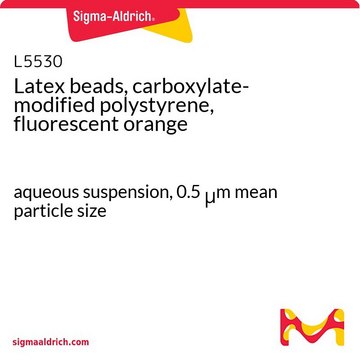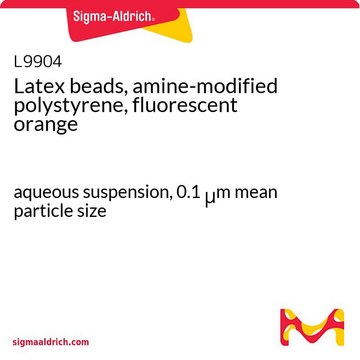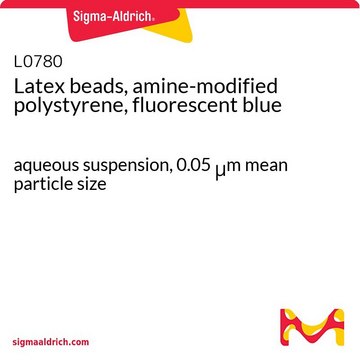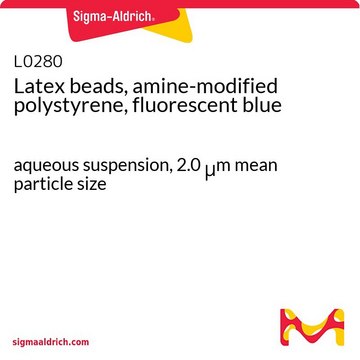LB3
Latex beads, polystyrene
0.3 μm mean particle size
Synonyme(s) :
Latex Microspheres, Polystyrene Beads, Polystyrene Latex Particles
Se connecterpour consulter vos tarifs contractuels et ceux de votre entreprise/organisme
About This Item
Produits recommandés
Forme
aqueous suspension
Composition
Solids, 10%
Conditionnement
pack of 1 mL
pack of 15 mL
pack of 2 mL
Taille moyenne des particules
0.3 μm
Vous recherchez des produits similaires ? Visite Guide de comparaison des produits
Description générale
Polystyrene microparticles are stabilized colloidal particles that are anionic. They are producedby the polymerization of styrene under conditions that induce spontaneouscoalescent bead formation. Latex particles are ideal for phagocytosisexperiments, antibody-mediated agglutination diagnostics, electron microscopy,and cell counter calibration.
Application
Polystyrene latex beads have been used:
- in latex particle recovery and size distribution studies
- as a component of the colloidal suspensions for light extinction spectroscopy
- in the quantification of microvesicles by high-sensitivity flow cytometry
Code de la classe de stockage
10 - Combustible liquids
Classe de danger pour l'eau (WGK)
WGK 3
Point d'éclair (°F)
Not applicable
Point d'éclair (°C)
Not applicable
Faites votre choix parmi les versions les plus récentes :
Déjà en possession de ce produit ?
Retrouvez la documentation relative aux produits que vous avez récemment achetés dans la Bibliothèque de documents.
Les clients ont également consulté
Light extinction spectroscopy applied to polystyrene colloids: Sensitivity to complex refractive index uncertainties and to noise
Eneren P, et al.
Journal of Quantitative Spectroscopy & Radiative Transfer, 261, 107494-107494 (2021)
Richard Ortega et al.
Particle and fibre toxicology, 11, 14-14 (2014-03-29)
The mechanisms of toxicity of metal oxide particles towards lung cells are far from being understood. In particular, the relative contribution of intracellular particulate versus solubilized fractions is rarely considered as it is very challenging to assess, especially for low-solubility
Chiara Uboldi et al.
Particle and fibre toxicology, 13, 5-5 (2016-02-05)
Poorly soluble cobalt (II, III) oxide particles (Co3O4P) are believed to induce in vitro cytotoxic effects via a Trojan-horse mechanism. Once internalized into lysosomal and acidic intracellular compartments, Co3O4P slowly release a low amount of cobalt ions (Co(2+)) that impair
Yu Chen et al.
Journal of biophotonics, 10(11), 1411-1420 (2017-04-19)
Optical coherence microscopy (OCM) has unique advantages of non-invasive 3D imaging without the need of exogenous labels for studying biological samples. However, the imaging depth of this technique is limited by the tradeoff between the depth of focus (DOF) and
Joanna Koziel et al.
PloS one, 4(4), e5210-e5210 (2009-04-22)
It is becoming increasingly apparent that Staphylococcus aureus are able to survive engulfment by macrophages, and that the intracellular environment of these host cells, which is essential to innate host defenses against invading microorganisms, may in fact provide a refuge
Notre équipe de scientifiques dispose d'une expérience dans tous les secteurs de la recherche, notamment en sciences de la vie, science des matériaux, synthèse chimique, chromatographie, analyse et dans de nombreux autres domaines..
Contacter notre Service technique








